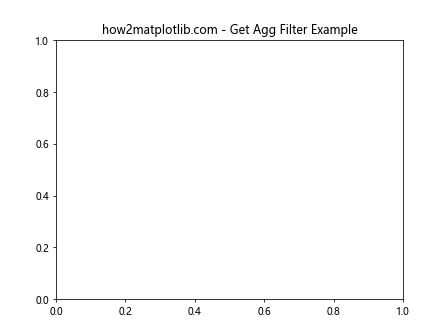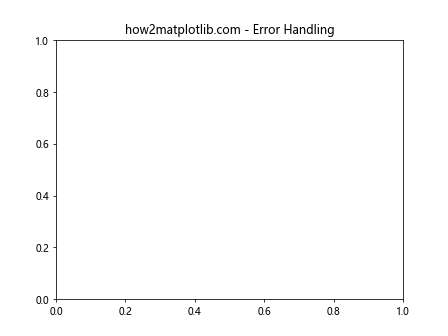Matplotlib中的Axis.get_agg_filter()函数:轴对象聚合滤镜获取详解
参考:Matplotlib.axis.Axis.get_agg_filter() function in Python
Matplotlib是Python中最流行的数据可视化库之一,它提供了丰富的绘图功能和自定义选项。在Matplotlib中,轴(Axis)是图表中的重要组成部分,负责管理坐标系统和刻度。本文将深入探讨Matplotlib中的Axis.get_agg_filter()函数,这是一个用于获取轴对象聚合滤镜的方法。我们将详细介绍其用法、应用场景以及与之相关的概念,并提供多个示例代码来帮助读者更好地理解和应用这个函数。
1. Axis.get_agg_filter()函数简介
Axis.get_agg_filter()是Matplotlib库中axis.Axis类的一个方法。这个函数的主要作用是获取当前轴对象的聚合滤镜(aggregation filter)。聚合滤镜是一种用于图形渲染过程中的特殊滤镜,可以影响轴及其相关元素的最终显示效果。
让我们先来看一个简单的示例,了解如何使用这个函数:
import matplotlib.pyplot as plt
fig, ax = plt.subplots()
ax.set_title("how2matplotlib.com - Get Agg Filter Example")
# 获取x轴的聚合滤镜
x_agg_filter = ax.xaxis.get_agg_filter()
print(f"X-axis aggregation filter: {x_agg_filter}")
plt.show()
Output:

在这个例子中,我们创建了一个简单的图表,然后使用get_agg_filter()方法获取x轴的聚合滤镜。通常情况下,如果没有特别设置,这个函数会返回None。
2. 聚合滤镜的概念和作用
聚合滤镜是一种用于图形渲染的高级技术,它可以在绘图过程中对图形元素进行特殊处理。在Matplotlib中,聚合滤镜主要用于以下几个方面:
- 图形平滑:可以使图形边缘更加平滑,减少锯齿感。
- 特殊效果:如模糊、锐化等效果的实现。
- 性能优化:在某些情况下,合适的聚合滤镜可以提高渲染性能。
虽然get_agg_filter()函数本身不设置滤镜,但它是我们了解和管理轴对象滤镜的重要工具。
3. 设置和获取聚合滤镜
要充分理解get_agg_filter(),我们还需要了解如何设置聚合滤镜。Matplotlib提供了set_agg_filter()方法来设置滤镜。让我们看一个例子:
import matplotlib.pyplot as plt
import numpy as np
def custom_filter(rgb, alpha, dpi):
return rgb * 0.8, alpha
fig, ax = plt.subplots()
ax.set_title("how2matplotlib.com - Custom Agg Filter")
x = np.linspace(0, 10, 100)
y = np.sin(x)
line, = ax.plot(x, y)
# 设置自定义滤镜
line.set_agg_filter(custom_filter)
# 获取并打印滤镜
print(f"Line agg filter: {line.get_agg_filter()}")
plt.show()
在这个例子中,我们定义了一个自定义的滤镜函数custom_filter,它将RGB值降低20%。我们将这个滤镜应用到线条上,然后使用get_agg_filter()获取并打印滤镜信息。
4. Axis.get_agg_filter()的返回值
Axis.get_agg_filter()函数的返回值可能有以下几种情况:
None:如果没有设置聚合滤镜,函数返回None。- 函数对象:如果设置了自定义的滤镜函数,会返回该函数对象。
- 滤镜名称:某些预定义的滤镜可能会返回一个字符串,表示滤镜的名称。
让我们通过一个例子来展示这些不同的返回值:
import matplotlib.pyplot as plt
fig, (ax1, ax2, ax3) = plt.subplots(1, 3, figsize=(15, 5))
ax1.set_title("how2matplotlib.com - No Filter")
ax2.set_title("how2matplotlib.com - Custom Filter")
ax3.set_title("how2matplotlib.com - Named Filter")
def custom_filter(rgb, alpha, dpi):
return rgb, alpha
# 不设置滤镜
print(f"Axis 1 filter: {ax1.xaxis.get_agg_filter()}")
# 设置自定义滤镜
ax2.xaxis.set_agg_filter(custom_filter)
print(f"Axis 2 filter: {ax2.xaxis.get_agg_filter()}")
# 设置命名滤镜(注:这只是一个假设的例子,Matplotlib实际上没有内置的命名滤镜)
ax3.xaxis.set_agg_filter("blur")
print(f"Axis 3 filter: {ax3.xaxis.get_agg_filter()}")
plt.tight_layout()
plt.show()
这个例子展示了三种不同的情况:没有滤镜、自定义滤镜和假设的命名滤镜。通过打印每个轴的get_agg_filter()结果,我们可以看到不同的返回值。
5. 在不同图形元素上使用get_agg_filter()
虽然我们主要讨论的是Axis.get_agg_filter(),但实际上Matplotlib中的许多其他图形元素也支持聚合滤镜。让我们看一些例子:
5.1 在线条上使用get_agg_filter()
import matplotlib.pyplot as plt
import numpy as np
fig, ax = plt.subplots()
ax.set_title("how2matplotlib.com - Line Agg Filter")
x = np.linspace(0, 10, 100)
y = np.sin(x)
line, = ax.plot(x, y)
def line_filter(rgb, alpha, dpi):
return rgb * 0.5, alpha
line.set_agg_filter(line_filter)
print(f"Line agg filter: {line.get_agg_filter()}")
plt.show()
这个例子展示了如何在线条对象上设置和获取聚合滤镜。
5.2 在文本对象上使用get_agg_filter()
import matplotlib.pyplot as plt
fig, ax = plt.subplots()
ax.set_title("how2matplotlib.com - Text Agg Filter")
def text_filter(rgb, alpha, dpi):
return rgb, alpha * 0.7
text = ax.text(0.5, 0.5, "how2matplotlib.com", ha='center', va='center')
text.set_agg_filter(text_filter)
print(f"Text agg filter: {text.get_agg_filter()}")
plt.show()
这个例子展示了如何在文本对象上设置和获取聚合滤镜。
6. 聚合滤镜与其他图形属性的交互
聚合滤镜可以与其他图形属性结合使用,以创造更丰富的视觉效果。让我们看一些例子:
6.1 结合透明度
import matplotlib.pyplot as plt
import numpy as np
fig, ax = plt.subplots()
ax.set_title("how2matplotlib.com - Filter with Alpha")
x = np.linspace(0, 10, 100)
y = np.sin(x)
def alpha_filter(rgb, alpha, dpi):
return rgb, alpha * 0.5
line, = ax.plot(x, y, alpha=0.8)
line.set_agg_filter(alpha_filter)
print(f"Line agg filter: {line.get_agg_filter()}")
plt.show()
这个例子展示了如何将聚合滤镜与透明度设置结合使用。
6.2 结合颜色映射
import matplotlib.pyplot as plt
import numpy as np
fig, ax = plt.subplots()
ax.set_title("how2matplotlib.com - Filter with Colormap")
x = np.linspace(0, 10, 20)
y = np.sin(x)
colors = plt.cm.viridis(np.linspace(0, 1, len(x)))
def color_filter(rgb, alpha, dpi):
return rgb * 0.8, alpha
scatter = ax.scatter(x, y, c=colors)
scatter.set_agg_filter(color_filter)
print(f"Scatter agg filter: {scatter.get_agg_filter()}")
plt.colorbar(scatter)
plt.show()
这个例子展示了如何将聚合滤镜应用于使用颜色映射的散点图。
7. 动态更新聚合滤镜
在某些情况下,我们可能需要动态地更新聚合滤镜。虽然get_agg_filter()本身不提供更新功能,但我们可以结合set_agg_filter()来实现动态效果。
import matplotlib.pyplot as plt
import numpy as np
from matplotlib.animation import FuncAnimation
fig, ax = plt.subplots()
ax.set_title("how2matplotlib.com - Dynamic Agg Filter")
x = np.linspace(0, 10, 100)
y = np.sin(x)
line, = ax.plot(x, y)
def update_filter(frame):
def dynamic_filter(rgb, alpha, dpi):
return rgb * (0.5 + 0.5 * np.sin(frame / 10)), alpha
line.set_agg_filter(dynamic_filter)
print(f"Frame {frame}, filter: {line.get_agg_filter()}")
return line,
ani = FuncAnimation(fig, update_filter, frames=100, interval=50, blit=True)
plt.show()
这个例子创建了一个动画,其中线条的聚合滤镜随时间变化。我们可以在每一帧中使用get_agg_filter()来检查当前的滤镜状态。
8. 错误处理和异常情况
在使用get_agg_filter()时,我们也需要考虑可能出现的错误和异常情况。虽然这个函数本身不太可能引发异常,但在处理返回值时可能需要进行一些检查。
import matplotlib.pyplot as plt
fig, ax = plt.subplots()
ax.set_title("how2matplotlib.com - Error Handling")
try:
filter = ax.xaxis.get_agg_filter()
if filter is None:
print("No aggregation filter set.")
elif callable(filter):
print("Custom aggregation filter function set.")
else:
print(f"Unknown filter type: {type(filter)}")
except AttributeError:
print("This object does not support agg_filter.")
except Exception as e:
print(f"An unexpected error occurred: {e}")
plt.show()
Output:

这个例子展示了如何安全地获取和处理聚合滤镜,包括处理可能的异常情况。
9. 性能考虑
虽然聚合滤镜可以创造有趣的视觉效果,但它们也可能影响渲染性能。在使用get_agg_filter()和设置滤镜时,需要考虑以下几点:
- 滤镜复杂度:复杂的滤镜函数可能会显著增加渲染时间。
- 应用范围:将滤镜应用于大量元素可能会影响性能。
- 动态更新:频繁更新滤镜可能会导致性能下降。
让我们看一个简单的例子,展示如何在设置滤镜时考虑性能:
import matplotlib.pyplot as plt
import numpy as np
import time
fig, ax = plt.subplots()
ax.set_title("how2matplotlib.com - Performance Consideration")
x = np.linspace(0, 10, 1000)
y = np.sin(x)
def simple_filter(rgb, alpha, dpi):
return rgb * 0.8, alpha
def complex_filter(rgb, alpha, dpi):
return np.sin(rgb * 10) * 0.5 + 0.5, alpha
line, = ax.plot(x, y)
# 测试简单滤镜
start_time = time.time()
line.set_agg_filter(simple_filter)
print(f"Simple filter set. Time: {time.time() - start_time:.5f} seconds")
print(f"Current filter: {line.get_agg_filter()}")
# 测试复杂滤镜
start_time = time.time()
line.set_agg_filter(complex_filter)
print(f"Complex filter set. Time: {time.time() - start_time:.5f} seconds")
print(f"Current filter: {line.get_agg_filter()}")
plt.show()
这个例子比较了简单滤镜和复杂滤镜的设置时间,帮助我们理解滤镜复杂度对性能的影响。
10. 与其他Matplotlib功能的集成
get_agg_filter()函数可以与Matplotlib的其他功能结合使用,以创建更复杂和有趣的可视化效果。让我们看几个例子:
10.1 结合自定义样式
import matplotlib.pyplot as plt
import numpy as np
plt.style.use('seaborn')
fig, ax = plt.subplots()
ax.set_title("how2matplotlib.com - Custom Stylewith Agg Filter")
x = np.linspace(0, 10, 100)
y = np.sin(x)
def custom_filter(rgb, alpha, dpi):
return rgb * 0.9, alpha
line, = ax.plot(x, y, linewidth=2, color='red')
line.set_agg_filter(custom_filter)
print(f"Line agg filter: {line.get_agg_filter()}")
plt.show()
这个例子展示了如何将聚合滤镜与自定义样式结合使用。
10.2 在子图中使用滤镜
import matplotlib.pyplot as plt
import numpy as np
fig, (ax1, ax2) = plt.subplots(1, 2, figsize=(12, 5))
fig.suptitle("how2matplotlib.com - Subplots with Agg Filters")
x = np.linspace(0, 10, 100)
y1 = np.sin(x)
y2 = np.cos(x)
def filter1(rgb, alpha, dpi):
return rgb * 0.8, alpha
def filter2(rgb, alpha, dpi):
return rgb * 1.2, alpha
line1, = ax1.plot(x, y1)
line1.set_agg_filter(filter1)
ax1.set_title("Subplot 1")
print(f"Line 1 agg filter: {line1.get_agg_filter()}")
line2, = ax2.plot(x, y2)
line2.set_agg_filter(filter2)
ax2.set_title("Subplot 2")
print(f"Line 2 agg filter: {line2.get_agg_filter()}")
plt.tight_layout()
plt.show()
这个例子展示了如何在不同的子图中使用不同的聚合滤镜。
11. 高级应用:自定义复杂滤镜
虽然简单的滤镜已经能够实现很多效果,但有时我们可能需要更复杂的滤镜来实现特定的视觉效果。让我们看一个更高级的例子:
import matplotlib.pyplot as plt
import numpy as np
fig, ax = plt.subplots()
ax.set_title("how2matplotlib.com - Advanced Custom Filter")
x = np.linspace(0, 10, 100)
y = np.sin(x)
def advanced_filter(rgb, alpha, dpi):
# 创建一个渐变效果
gradient = np.linspace(0.5, 1, rgb.shape[0])[:, np.newaxis]
rgb_adjusted = rgb * gradient
# 添加一些噪声
noise = np.random.normal(0, 0.05, rgb.shape)
rgb_with_noise = np.clip(rgb_adjusted + noise, 0, 1)
return rgb_with_noise, alpha
line, = ax.plot(x, y, linewidth=3)
line.set_agg_filter(advanced_filter)
print(f"Advanced filter applied: {line.get_agg_filter()}")
plt.show()
这个例子创建了一个更复杂的滤镜,它结合了渐变效果和随机噪声。
12. 滤镜的实际应用场景
了解了get_agg_filter()和相关的滤镜概念后,让我们探讨一些实际的应用场景:
12.1 数据可视化增强
import matplotlib.pyplot as plt
import numpy as np
fig, ax = plt.subplots()
ax.set_title("how2matplotlib.com - Enhanced Data Visualization")
np.random.seed(42)
data = np.random.normal(0, 1, 1000)
def enhance_filter(rgb, alpha, dpi):
# 增强对比度
return np.power(rgb, 0.8), alpha
hist = ax.hist(data, bins=30, alpha=0.7)
for patch in hist[2]:
patch.set_agg_filter(enhance_filter)
print(f"Histogram patch filter: {hist[2][0].get_agg_filter()}")
plt.show()
这个例子展示了如何使用滤镜来增强直方图的视觉效果。
12.2 强调特定数据点
import matplotlib.pyplot as plt
import numpy as np
fig, ax = plt.subplots()
ax.set_title("how2matplotlib.com - Emphasizing Data Points")
x = np.linspace(0, 10, 100)
y = np.sin(x)
def emphasize_filter(rgb, alpha, dpi):
return rgb, np.where(rgb.mean(axis=-1) > 0.8, 1, 0.3)
scatter = ax.scatter(x, y, c=y, cmap='viridis')
scatter.set_agg_filter(emphasize_filter)
print(f"Scatter plot filter: {scatter.get_agg_filter()}")
plt.colorbar(scatter)
plt.show()
这个例子使用滤镜来强调散点图中的特定数据点。
13. 滤镜与动画的结合
滤镜可以与动画结合,创造出动态的视觉效果。让我们看一个例子:
import matplotlib.pyplot as plt
import numpy as np
from matplotlib.animation import FuncAnimation
fig, ax = plt.subplots()
ax.set_title("how2matplotlib.com - Animated Filter")
x = np.linspace(0, 10, 100)
y = np.sin(x)
line, = ax.plot(x, y)
def animate(frame):
def dynamic_filter(rgb, alpha, dpi):
phase = frame / 30 * np.pi
return rgb * (0.7 + 0.3 * np.sin(phase)), alpha
line.set_agg_filter(dynamic_filter)
print(f"Frame {frame}, filter: {line.get_agg_filter()}")
return line,
ani = FuncAnimation(fig, animate, frames=60, interval=50, blit=True)
plt.show()
这个例子创建了一个动画,其中线条的颜色强度随时间变化。
14. 滤镜在3D图形中的应用
虽然我们主要讨论了2D图形,但滤镜也可以应用于3D图形。让我们看一个例子:
import matplotlib.pyplot as plt
import numpy as np
from mpl_toolkits.mplot3d import Axes3D
fig = plt.figure()
ax = fig.add_subplot(111, projection='3d')
ax.set_title("how2matplotlib.com - 3D Plot with Filter")
x = np.linspace(-5, 5, 50)
y = np.linspace(-5, 5, 50)
X, Y = np.meshgrid(x, y)
Z = np.sin(np.sqrt(X**2 + Y**2))
def surface_filter(rgb, alpha, dpi):
return rgb * 0.8, alpha
surf = ax.plot_surface(X, Y, Z, cmap='viridis')
surf.set_agg_filter(surface_filter)
print(f"Surface plot filter: {surf.get_agg_filter()}")
plt.show()
这个例子展示了如何在3D表面图上应用滤镜。
15. 总结
通过本文的详细探讨,我们深入了解了Matplotlib中的Axis.get_agg_filter()函数及其相关概念。我们学习了如何获取、设置和使用聚合滤镜,以及如何将滤镜应用于各种图形元素。我们还探讨了滤镜的高级应用、性能考虑和实际应用场景。
聚合滤镜是Matplotlib中一个强大但相对较少被使用的功能。通过合理使用滤镜,我们可以创造出更加丰富和吸引人的数据可视化效果。然而,在使用滤镜时,我们也需要注意平衡视觉效果和性能,确保我们的可视化既美观又高效。
 极客笔记
极客笔记